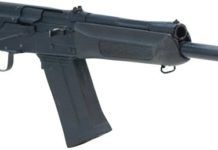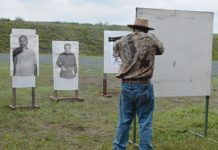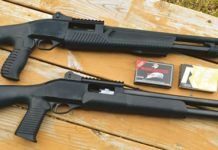How much do you need to spend to get a really good O/U? Just this year someone bought a fine O/U .410, made by Woodward in 1940, for $200,500 at auction. He obviously thought it was worth it. But must you spend into five figures for a really good O/U? Probably not. Can you buy a really fine O/U for less than a grand? Again, probably not, though there are exceptions. If you can get a good O/U like a Ruger Red Label for around $1,200, why should you spend twice that? Things that might be important include fine wood, superior inletting, hand fitting of all metal and wood parts, engraving, better wood and metal finishes, superior balance and handling, and you take it from there. Only you can tell if these things make a difference to you.
We deal here with two O/U’s that climb partway up the cost curve, but go nowhere near Woodward land. We recently tested Sigarms’ SA 5 Upland Hunter, $2,670, and the Beretta Model S687 Silver Pigeon Sporting, $2,270. Both are fine shotguns with nice, but not extremely fancy, wood stocks. Both have so-called coin-finished actions, which means they are essentially white, and both have impressed “engraving” of scrolls and game-bird scenes. They are single-trigger guns with gold-plated triggers, and they both have ejectors, slim recoil pads, ventilated ribs, and are chambered for 12-gauge shells. Both have replaceable choke tube inserts to tailor the gun to your needs, a set of five with the Sigarms, and four with the Beretta. But that’s where the similarities end, and our evaluation begins:
Beretta S687 Silver Pigeon Sporting
Our recommendation: In our view, this gun is slower than the SA 5. But its extra weight makes it a better Sporting gun than the SIG.
Pick up the Beretta Silver Pigeon and mount it, and it falls into place like it was meant to be there. At 7.7 pounds it’s heavier than the SA 5, but if you intend to shoot a lot, a bit of extra weight is probably a good thing. The gun feels so good you know you’ll shoot it well, and we did.
Functionally as well as visually, this 3-inch-chambered gun has a lot going for it. Like the Sigarms SA 5, the Beretta is built on the mono-bloc principal. The action is locked closed by two rods or bolts that enter into holes at either side of the breech, between the upper and lower barrels.
The stock finish is evenly applied, and appears to be a durable synthetic. The checkering is awkward-looking at the pistol grip, and sparse but clean on the forend. The overall inletting is not quite as good as that on the SA 5, but very good nonetheless. The metal-to-metal fitting of the Beretta is as good as that on the Sigarms SA 5. The finish on the sides of the Beretta where the game scene is placed is notably superior to that of the Sigarms.
The trigger pulls were 3.25 pounds for the upper barrel and 4.5 for the bottom. With two pulls, both hammers fall whether or not each round fires. The non-auto safety was quite stiff, though a bit of oil improved it greatly. Particularly noteworthy was the rounded top of the Beretta’s recoil pad, which, combined with its slick surface, made mounting very fast. We also greatly liked this gun’s castoff, which made the two beads mounted on its 0.4-inch-wide rib fall right in line with our eye.
Sigarms SA5 Upland Hunter
Our recommendation: We’d buy this $2,670 Italian-made gun if we wanted a classy, good-looking upland O/U that didn’t cost a second mortgage to buy. It’s a great gun with outstanding workmanship and fine handling qualities for a reasonable price, though for that price we’d like the wood pores to be filled.
This fine, well-balanced shotgun is made in Italy by Rizzini, and imported in its solidly made, lockable plastic case under the SIG (which stands for Swiss Industries, Incorporated) banner by Sigarms. Ours was the field-grade 12-gauge, 3-inch chambers. The gun appears clean and classic, and our testing reinforced our first impressions, though we doubt the need for 3-inch chambers on an upland gun.
Our test gun was a boxlock with false sideplates. These serve but one function: they increase the area for engraving. However, in spite of the instruction manual’s declaration that these guns are hand engraved, we suspect this one was done by machine. Nonetheless, it looks very good indeed. The SA 5 is a boxlock or, more specifically, a blitz action with all the lock mechanism affixed to the trigger plate. Lockup of the SA 5 is by a bar entering into lugs under the bottom barrel. Lockup was secure, though the top lever was nowhere near center when the gun was fully closed. As far as handling, our SA 5 was very lively. It felt like greased lightning next to the heavier Beretta, although the Beretta was steadier on targets. At 7.3 pounds, it was not as light as a good British game gun, but far lighter than any autoloader or pump we’ve tried.
The single trigger was recoil set. The trigger worked very well, and the pull was totally acceptable and exactly the same (3.5 pounds) for both barrels. This gun had perfectly timed ejectors. The effort needed to close the gun after both ejectors had fired was the same as if the gun were unfired, and that is no mean trick of gun-building. All the metalwork was quite good, though the engine turning inside the action began to show a few scratches after the gun had been opened and closed a few times. The forend had a diamond-shaped insert of wood inlayed into its underside, and it was not flush with the forend surface. All the screw slots on the SA 5 are thinner than an X-Acto knife blade, and we wonder how they can be removed. We didn’t try.
The flat-topped checkering was uneven, and it didn’t carry the same depth to the ends of the rows.The stock had an “oil” finish, and while it let you see the wood grain to good effect, the pores were not fully filled. Inletting was extremely good, as was the metal-to-metal fit. The gun had a bit of cast, though mostly noticeable at the toe of the buttstock. The rough and slightly sticky finish of the rubber buttpad made mounting the SA 5 somewhat problematical. It was far easier to get the Beretta up to the shoulder.
Gun Tests Recommends
All told, we’d pick the SIG SA 5 Upland gun for our upland hunting over the Beretta because of the weight advantage and its extremely fast handling qualities.
The Beretta S687 Silver Pigeon Sporting would be ideal for extended Sporting Clays competition, and for occasional upland game hunting. There are lighter guns for field work, though we’d be surprised if there were more precise or longer-lasting guns for Sporting Clays shooting.





























